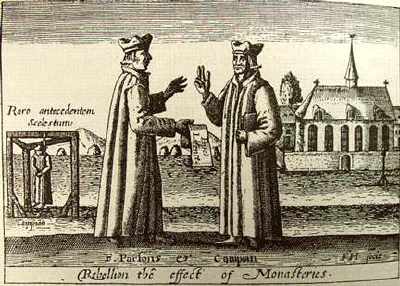The Catholics under Elizabeth
Elizabeth's treatment of Catholics was moderate* in contrast with the burning of Protestants in Mary's reign, but any public worship other than Anglicanism was punishable, and penal laws affecting Catholics became increasingly severe*.
Elizabeth's choice of a middle path was initially effective in foreign policy, since an ambiguous national religion allowed a degree of flexibility. That most Catholics were satisfied with Elizabeth's compromise was shown by their refusal to support the Northern Rebellion of 1569, intended to place Mary Stuart on the throne. The Catholics were still seen as a threat, however, for a variety of reasons.*
The "gunpowder plot"
In 1605, two years after Elizabeth's death, the severe penal laws against Catholics led to a conspiracy to blow up Parliament and James I-- and it very nearly succeeded. However, secrecy was made virtually impossible by the large number of persons involved, one of whom sent a letter warning one peer not to attend the first day of Parliament.
Investigations revealed 60 barrels of gunpowder in the cellar beneath the House of Lords, and one conspirator (Guy Fawkes) was apprehended as he was about to carry out the plan. Most of his associates were imprisoned or executed. The main results of the plot were increased animosity towards Catholics and more severe penal laws. Guy Fawkes Day (Nov. 5) celebrated hatred of the Catholics with fireworks and the burning of effigies (even to the present day).
Footnotes
-
Moderation
Catholics enjoyed about 11 years of relative tolerance, when they were merely barred from various public offices, and levied small fines for not attending church.
-
Severity
Beginning in 1571, Parliament enacted harsher laws against Catholics, greatly increasing fines, confiscating property, imposing life imprisonment for refusal to take the oath of Supremacy, and applying the death penalty to all missionaries or Catholic priests--there were well over a hundred executions by hanging, drawing, and quartering during the last 30 years of Elizabeth's reign. (The numbers are seemingly modest by Mary's standards, but some have questioned the reliability of information on executions in both reigns, since they are primarily derived from Protestant sources.)
But Catholics were a minority even at the start of her reign, and were concentrated mainly in northern counties such as Lancashire; in these areas feudal society lingered on and religious issues merged with the struggle of the nobility to retain their ancient privileges and power.
-
The Catholic threat
Although Catholic numbers did not dwindle until the 1570s, their numbers were largely concentrated in the northern counties such as Lancashire; nonetheless, Elizabeth was eventually forced to tilt the balance in favour of Protestantism.
- Religious wars erupted in France, and Catholic
powers began to take a more active role in
suppressing Protestantism throughout Europe
(the Counter-Reformation);
- Spain moved its troops into the Netherlands,
threatening English trade;
- Mary
Stuart arrived in 1568--a dangerous
potential rival to the Queen.
- The Pope excommunicated and "deposed"
Elizabeth (1570), urging Catholics to revolt;
- By 1574 the first Catholic missionaries appeared
in England from the continent, led by English
exiles, and later by Jesuits, who had a reputation for duplicity.
Protestants were justifiably concerned at what appeared to be an international Catholic conspiracy and pressured Elizabeth to support Protestants in France and the Netherlands; if England failed to do so, it might mean the victory of Catholicism on the Continent and England's complete isolation.
- Religious wars erupted in France, and Catholic
